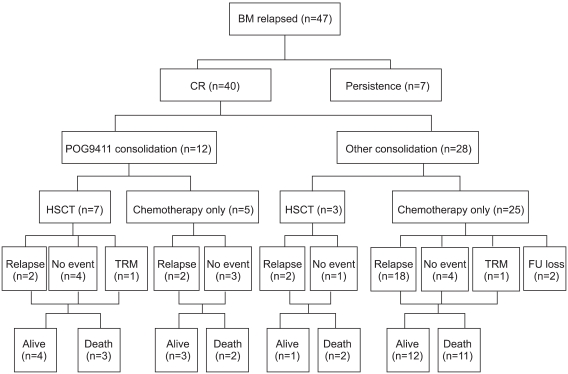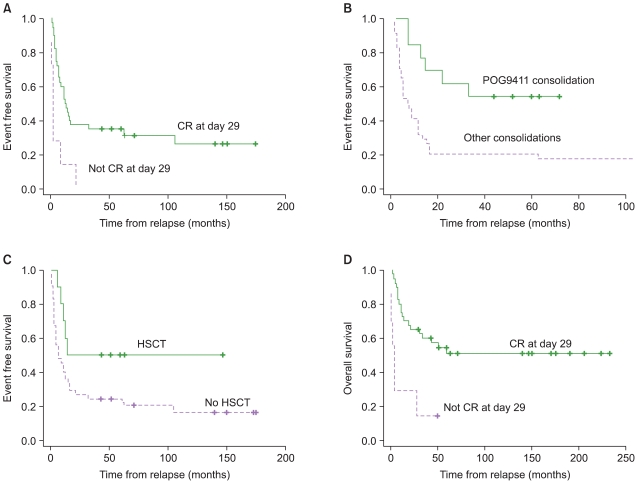Korean J Hematol.
2010 Jun;45(2):109-114. 10.5045/kjh.2010.45.2.109.
Improved outcome in childhood ALL with intensive consolidation and hematopoietic stem cell transplant
- Affiliations
-
- 1Department of Pediatric, Inje University Haeundae Baik Hospital, Inje University College of Medicine, Busan, Korea.
- 2Department of Pediatrics, Hematology and Oncology, Emory University School of Medicine, Atlanta, GA, USA.
- 3Department of Pediatrics, Asan Medical Center, University of Ulsan College of Medicine, Seoul, Korea. jjseo@amc.seoul.kr
- KMID: 2083543
- DOI: http://doi.org/10.5045/kjh.2010.45.2.109
Abstract
- BACKGROUND
Despite advances in chemotherapy, the prognosis of relapsed acute lymphoblastic leukemia (ALL) remains poor. Few studies on relapsed ALL have reported the importance of intensive consolidation followed with or without allogeneic hematopoietic stem cell transplantation (HSCT).
METHODS
We evaluated the post-relapse outcomes in 47 Korean children with a first marrow relapse, and analyzed the prognostic factors.
RESULTS
A second complete remission (CR) was achieved in 40 patients (85.1%), and at the time of this study, second CR was maintained in 12 of these patients. The estimated 3-yr event-free survival (EFS) rate after the first marrow relapse was 29.8+/-6.7%, and the overall survival (OS) rate was 45.3+/-7.5%. We found that second remission, consolidation of pediatric oncology group chemotherapy regimen (POG 9411), and HSCT significantly affected the outcome of the disease after relapse (P<0.001; P=0.004; P=0.05).
CONCLUSION
The results of our study revealed that an intensified POG 9411 consolidation chemotherapy regimen followed by HSCT can improve the outcome of patients with relapsed ALL.
Keyword
MeSH Terms
Figure
Reference
-
1. Chessells JM. Treatment of childhood acute lymphoblastic leukaemia: present issues and future prospects. Blood Rev. 1992; 6:193–203. PMID: 1486288.
Article2. Rivera GK, Raimondi SC, Hancock ML, et al. Improved outcome in childhood acute lymphoblastic leukaemia with reinforced early treatment and rotational combination chemotherapy. Lancet. 1991; 337:61–66. PMID: 1670723.
Article3. Chessells JM. Relapsed lymphoblastic leukaemia in children: a continuing challenge. Br J Haematol. 1998; 102:423–438. PMID: 9695956.4. Uckun FM, Nachman JB, Sather HN, et al. Poor treatment outcome of Philadelphia chromosome-positive pediatric acute lymphoblastic leukemia despite intensive chemotherapy. Leuk Lymphoma. 1999; 33:101–106. PMID: 10194126.
Article5. Hutchinson RJ, Gaynon PS, Sather H, et al. Intensification of therapy for children with lower-risk acute lymphoblastic leukemia: long-term follow-up of patients treated on Children's Cancer Group Trial 1881. J Clin Oncol. 2003; 21:1790–1797. PMID: 12721256.
Article6. Heath JA, Steinherz PG, Altman A, et al. Human granulocyte colony-stimulating factor in children with high-risk acute lymphoblastic leukemia: a Children's Cancer Group Study. J Clin Oncol. 2003; 21:1612–1617. PMID: 12697887.
Article7. Gaynon PS, Steinherz PG, Bleyer WA, et al. Intensive therapy for children with acute lymphoblastic leukaemia and unfavourable presenting features. Early conclusions of study CCG-106 by the Childrens Cancer Study Group. Lancet. 1988; 2:921–924. PMID: 2902379.8. Gaynon PS, Harris RE, Altman AJ, et al. Bone marrow transplantation versus prolonged intensive chemotherapy for children with acute lymphoblastic leukemia and an initial bone marrow relapse within 12 months of the completion of primary therapy: Children's Oncology Group study CCG-1941. J Clin Oncol. 2006; 24:3150–3156. PMID: 16717292.
Article9. Feig SA, Harris RE, Sather HN. Bone marrow transplantation versus chemotherapy for maintenance of second remission of childhood acute lymphoblastic leukemia: a study of the Childrens Cancer Group (CCG-1884). Med Pediatr Oncol. 1997; 29:534–540. PMID: 9324340.
Article10. Smith M, Arthur D, Camitta B, et al. Uniform approach to risk classification and treatment assignment for children with acute lymphoblastic leukemia. J Clin Oncol. 1996; 14:18–24. PMID: 8558195.
Article11. Wheeler K, Richards S, Bailey C, Chessells J. Comparison of bone marrow transplant and chemotherapy for relapsed childhood acute lymphoblastic leukaemia: the MRC UKALL X experience. Medical Research Council Working Party on Childhood Leukaemia. Br J Haematol. 1998; 101:94–103. PMID: 9576189.12. Borgmann A, von Stackelberg A, Hartmann R, et al. Unrelated donor stem cell transplantation compared with chemotherapy for children with acute lymphoblastic leukemia in a second remission: a matched-pair analysis. Blood. 2003; 101:3835–3839. PMID: 12732501.
Article13. Chessells JM, Veys P, Kempski H, et al. Long-term follow-up of relapsed childhood acute lymphoblastic leukaemia. Br J Haematol. 2003; 123:396–405. PMID: 14616997.
Article14. Nguyen K, Devidas M, Cheng SC, et al. Factors influencing survival after relapse from acute lymphoblastic leukemia: a Children's Oncology Group study. Leukemia. 2008; 22:2142–2150. PMID: 18818707.
Article15. Henze G, Fengler R, Hartmann R, Niethammer D, Schellong G, Riehm H. BFM group treatment results in relapsed childhood acute lymphoblastic leukemia. Haematol Blood Transfus. 1990; 33:619–626. PMID: 2182452.
Article16. Buchanan GR, Rivera GK, Pollock BH, et al. Alternating drug pairs with or without periodic reinduction in children with acute lymphoblastic leukemia in second bone marrow remission: a Pediatric Oncology Group Study. Cancer. 2000; 88:1166–1174. PMID: 10699908.17. Malempati S, Gaynon PS, Sather H, La MK, Stork LC. Outcome after relapse among children with standard-risk acute lymphoblastic leukemia: Children's Oncology Group study CCG-1952. J Clin Oncol. 2007; 25:5800–5807. PMID: 18089878.
Article18. Seibel NL, Steinherz PG, Sather HN, et al. Early postinduction intensification therapy improves survival for children and adolescents with high-risk acute lymphoblastic leukemia: a report from the Children's Oncology Group. Blood. 2008; 111:2548–2555. PMID: 18039957.19. Paganin M, Zecca M, Fabbri G, et al. Minimal residual disease is an important predictive factor of outcome in children with relapsed 'high-risk' acute lymphoblastic leukemia. Leukemia. 2008; 22:2193–2200. PMID: 18754029.
Article20. Mehta PA, Davies SM. Pre-transplant minimal residual disease in children with acute lymphoblastic leukemia. Pediatr Blood Cancer. 2007; 48:1–2. PMID: 16642487.
Article21. Krejci O, van der Velden VH, Bader P, et al. Level of minimal residual disease prior to haematopoietic stem cell transplantation predicts prognosis in paediatric patients with acute lymphoblastic leukaemia: a report of the Pre-BMT MRD Study Group. Bone Marrow Transplant. 2003; 32:849–851. PMID: 14520434.
Article22. zur Stadt U, Harms DO, Schlüter S, et al. MRD at the end of induction therapy in childhood acute lymphoblastic leukemia: outcome prediction strongly depends on the therapeutic regimen. Leukemia. 2001; 15:283–285. PMID: 11236947.
Article23. Matsuzaki A, Nagatoshi Y, Inada H, et al. Prognostic factors for relapsed childhood acute lymphoblastic leukemia: impact of allogeneic stem cell transplantation--a report from the Kyushu-Yamaguchi Children's Cancer Study Group. Pediatr Blood Cancer. 2005; 45:111–120. PMID: 15782402.
Article24. Boulad F, Steinherz P, Reyes B, et al. Allogeneic bone marrow transplantation versus chemotherapy for the treatment of childhood acute lymphoblastic leukemia in second remission: a single-institution study. J Clin Oncol. 1999; 17:197–207. PMID: 10458234.
Article25. Barrett AJ, Horowitz MM, Pollock BH, et al. Bone marrow transplants from HLA-identical siblings as compared with chemotherapy for children with acute lymphoblastic leukemia in a second remission. N Engl J Med. 1994; 331:1253–1258. PMID: 7935682.
Article26. Eapen M, Raetz E, Zhang MJ, et al. Outcomes after HLA-matched sibling transplantation or chemotherapy in children with B-precursor acute lymphoblastic leukemia in a second remission: a collaborative study of the Children's Oncology Group and the Center for International Blood and Marrow Transplant Research. Blood. 2006; 107:4961–4967. PMID: 16493003.
Article
- Full Text Links
- Actions
-
Cited
- CITED
-
- Close
- Share
- Similar articles
-
- Allogeneic hematopoietic stem cell transplantation for myelodysplastic syndromes
- Hematopoietic stem cell transplantation: overview for general pediatrician
- Common Infectious Diseases in Hematopoietic Stem Cell Transplant Recipients
- Comparative Results of Autologous Hematopoietic Stem Cell Transplantation in Childhood Acute Myeloid Leukemia Patients with Continuous Complete Remission during Consolidation Chemotherapy
- The role of allogeneic hematopoietic stem cell transplantation in the four P medicine era



